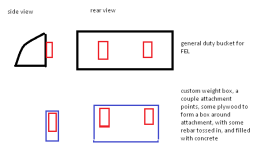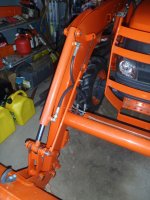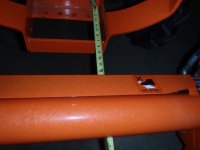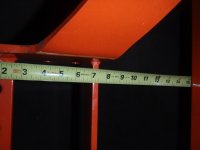You are using an out of date browser. It may not display this or other websites correctly.
You should upgrade or use an alternative browser.
You should upgrade or use an alternative browser.
compatibility of grill guard with front suitcase weights
- Thread starter DonaldWB
- Start date
- Views: 6196
/ compatibility of grill guard with front suitcase weights
#11
Thanks, everybody. This is very helpful.
94Bullit/Roger: Your grill guard looks just like mine. What model loader do you have? If it is a LA 724 then your grill guard is the same and I'm safe.
Thank you,
Donald
The loader is a LA854. I'm not sure if they made a different grill guard than this one.
wmonroe
Elite Member
I thought some came with a fold down guard?
David_Kb7uns
Veteran Member
My neighbor had similar problems with his BX, if you had a weight bracket to look at you should be able to get float and angle stock to weld to your grill guard so you can hang the weights.
David Kb7uns
David Kb7uns
boggen
Elite Member
- Joined
- Feb 22, 2011
- Messages
- 3,789
- Location
- Trivoli, IL
- Tractor
- SSTT (Sideways Snake Tain Tractor) and STB (sideways train box) tractor, dirt harvester
looking at tractordata
TractorData.com Kubota L3540 tractor information
what are you doing that requires taking the FEL off? the FEL itself is counter weight on the front.
seems like a lot of micro managing, trying to wiggle tractor into tightest spots possible. and guessing only for a couple spots. that one could reverse/forward a couple times and get done, due to dealing with FEL sticking out in front. vs jacking around taking FEL off and swapping in/out weights on the front.
========
no FEL and extra weights + grill guard for weights = cheaper setup when buying unit used, and guessing tractor would only see things on 3pt hitch and/or pulling stuff.
vs
the FEL + grill guard for it = more expensive setup, when buying new. front weights + FEL on at same time = reduced weight FEL can lift up, without damaging the front axles and snaping/bending something.
i could see wanting to add some weight to the front, and reduce how much the FEL stuck out in front, when operating some 3pt hitch stuff. but... question is are you just wanting to spend money, due to it is burning a hole in your pocket or other? the only real thing i can think of, is if the tractor gets multi purposed, in spring/fall = field work. summer/winter multi task tractor. field work being the key issue, everything else i am kinda scratching my head about extra work pulling FELL off at all. maybe disconnect bucket from FEL. and create a custom weight that mounts to FEL? (instead of a 3pt hitch custom weight, a FEL custom weight). or strapping some weight into the FEL bucket.
===========
custom weight box, for FEL, remove general duty bucket, measure the brackets and hole locations, goto a local metal fab shop to get some brackets made up, and build a plywood box put in some rebar, and fill with concrete.

a reminder on grade school levers / fulcrums / a kids tetter totter... the further out the weight is in front, the more force it has to hold down the front wheels. 100lbs, 10 feet in front, vs 1000lbs 1 foot from front, type of thing.
the lower you can place the weight, the more you can lower the COG (center of gravity) of the tractor. other words weights at or above axles = more likely tractor tipping over, weight below axle's = less likely tractor to flip over.
============
lower your tire pressure in your tires. no need to run at max PSI. 10 to 15psi, get that traction.
fill rear tires with a fluid, see if operators manual for tractor suggest filling front tires or not with a fluid. for additional weight.
TractorData.com Kubota L3540 tractor information
what are you doing that requires taking the FEL off? the FEL itself is counter weight on the front.
seems like a lot of micro managing, trying to wiggle tractor into tightest spots possible. and guessing only for a couple spots. that one could reverse/forward a couple times and get done, due to dealing with FEL sticking out in front. vs jacking around taking FEL off and swapping in/out weights on the front.
========
no FEL and extra weights + grill guard for weights = cheaper setup when buying unit used, and guessing tractor would only see things on 3pt hitch and/or pulling stuff.
vs
the FEL + grill guard for it = more expensive setup, when buying new. front weights + FEL on at same time = reduced weight FEL can lift up, without damaging the front axles and snaping/bending something.
i could see wanting to add some weight to the front, and reduce how much the FEL stuck out in front, when operating some 3pt hitch stuff. but... question is are you just wanting to spend money, due to it is burning a hole in your pocket or other? the only real thing i can think of, is if the tractor gets multi purposed, in spring/fall = field work. summer/winter multi task tractor. field work being the key issue, everything else i am kinda scratching my head about extra work pulling FELL off at all. maybe disconnect bucket from FEL. and create a custom weight that mounts to FEL? (instead of a 3pt hitch custom weight, a FEL custom weight). or strapping some weight into the FEL bucket.
===========
custom weight box, for FEL, remove general duty bucket, measure the brackets and hole locations, goto a local metal fab shop to get some brackets made up, and build a plywood box put in some rebar, and fill with concrete.

a reminder on grade school levers / fulcrums / a kids tetter totter... the further out the weight is in front, the more force it has to hold down the front wheels. 100lbs, 10 feet in front, vs 1000lbs 1 foot from front, type of thing.
the lower you can place the weight, the more you can lower the COG (center of gravity) of the tractor. other words weights at or above axles = more likely tractor tipping over, weight below axle's = less likely tractor to flip over.
============
lower your tire pressure in your tires. no need to run at max PSI. 10 to 15psi, get that traction.
fill rear tires with a fluid, see if operators manual for tractor suggest filling front tires or not with a fluid. for additional weight.
ovrszd
Epic Contributor
- Joined
- May 27, 2006
- Messages
- 32,246
- Location
- Missouri
- Tractor
- Kubota M9540, Ford 3910FWD, Ford 555A, JD2210
looking at tractordata
TractorData.com Kubota L3540 tractor information
what are you doing that requires taking the FEL off? the FEL itself is counter weight on the front.
seems like a lot of micro managing, trying to wiggle tractor into tightest spots possible. and guessing only for a couple spots. that one could reverse/forward a couple times and get done, due to dealing with FEL sticking out in front. vs jacking around taking FEL off and swapping in/out weights on the front.
========
no FEL and extra weights + grill guard for weights = cheaper setup when buying unit used, and guessing tractor would only see things on 3pt hitch and/or pulling stuff.
vs
the FEL + grill guard for it = more expensive setup, when buying new. front weights + FEL on at same time = reduced weight FEL can lift up, without damaging the front axles and snaping/bending something.
i could see wanting to add some weight to the front, and reduce how much the FEL stuck out in front, when operating some 3pt hitch stuff. but... question is are you just wanting to spend money, due to it is burning a hole in your pocket or other? the only real thing i can think of, is if the tractor gets multi purposed, in spring/fall = field work. summer/winter multi task tractor. field work being the key issue, everything else i am kinda scratching my head about extra work pulling FELL off at all. maybe disconnect bucket from FEL. and create a custom weight that mounts to FEL? (instead of a 3pt hitch custom weight, a FEL custom weight). or strapping some weight into the FEL bucket.
===========
custom weight box, for FEL, remove general duty bucket, measure the brackets and hole locations, goto a local metal fab shop to get some brackets made up, and build a plywood box put in some rebar, and fill with concrete.
View attachment 402398
a reminder on grade school levers / fulcrums / a kids tetter totter... the further out the weight is in front, the more force it has to hold down the front wheels. 100lbs, 10 feet in front, vs 1000lbs 1 foot from front, type of thing.
the lower you can place the weight, the more you can lower the COG (center of gravity) of the tractor. other words weights at or above axles = more likely tractor tipping over, weight below axle's = less likely tractor to flip over.
============
lower your tire pressure in your tires. no need to run at max PSI. 10 to 15psi, get that traction.
fill rear tires with a fluid, see if operators manual for tractor suggest filling front tires or not with a fluid. for additional weight.
Wow, what a lengthy response. Seems you actually know more about the uses of his tractor than he does.
I remove my FEL frequently. Takes maybe 3 minutes to remove, 5 minutes to attach. I hate running a brush cutter with the FEL, especially in confined spaces such as timber.
As for weights, I use 7 125lb suitcase weights. I built a 3pt rack to store them on. That way the weights can be picked up on the 3pt for ballast or transfer them to my front rack for ballast when carrying my 3pt cutter.
It's common to see operators that never remove their FEL. But it's also common to find operators that utilize their tractors without the FEL. In the case of Kubotas, any I've been around were very easy to remove the FEL.
Baby Grand
Elite Member
- Joined
- Nov 12, 2007
- Messages
- 4,649
- Location
- Windsor, CT.
- Tractor
- Kubotas: L3240GST B2320HST B5100D & G5200H
looking at tractordata
TractorData.com Kubota L3540 tractor information
what are you doing that requires taking the FEL off? the FEL itself is counter weight on the front.
seems like a lot of micro managing, trying to wiggle tractor into tightest spots possible. and guessing only for a couple spots. that one could reverse/forward a couple times and get done, due to dealing with FEL sticking out in front. vs jacking around taking FEL off and swapping in/out weights on the front.
<snip>
Boggen - I like to cut brush with the LA724 FEL off. My trees, buildings and fences agree. But if I had a heavier cutter or some hilly spots, then being able to hang a few suitcase weights on the front would sure be a very nice option. I thought the grill guard was made to hang weights on, but now I can't remember - I'll hafta got out & take a look.
Last edited:
motownbrowne
Elite Member
- Joined
- Dec 30, 2013
- Messages
- 2,613
- Location
- river falls, wi
- Tractor
- Kubota mx4700 HST, New Holland TC-29D
Plenty of situations I encounter call for removing the loader. We farm veggies on low acreage. Being able to get close to hoop houses and into small spaces is often the name of the game. I think figuring out how to carry the weight and remove the loader should be worthwhile and shouldn't cost much, if any money.
Baby Grand
Elite Member
- Joined
- Nov 12, 2007
- Messages
- 4,649
- Location
- Windsor, CT.
- Tractor
- Kubotas: L3240GST B2320HST B5100D & G5200H
It sure looks like there's room for weights on the L3240's brush guard, even with the 724 FEL installed:






Last edited:

